Sat 29 Apr 2006
Sheep Have Feelings Too
Posted by Jim under George Miller/Riggfoot, History, John Miller/Thistle Ha', LoreComments Off on Sheep Have Feelings Too
As told by: Hugh Miller
The first of the family to emigrate to Canada was George Miller, who left Scotland in 1832, settling on Lot 16, Concession 9, Markham Township in York County. He called his property Riggfoot farm, after one of the local estates in the old country. His neighbours called him “Laird o’ Riggfoot”; he was known in the family as “Uncle Geordie”.
Like the rest of the Millers to follow, he was a pioneer in Canadian agriculture. His 1880 obituary [writer and newspaper unknown] notes that he was “the first of our agriculturalists who introduced the sowing of turnips in drills, and “among the first to import live stock from Great Britain.” His first known importation was a dozen Leicester sheep [a dual purpose breed, known particularly for its fine wool], and a pair of Yorkshire pigs [a brand new breed that debuted at the 1831 Royal Windsor Show]. It is said that Uncle Geordie was the first importer of Yorkshire pigs to Canada. His nephew, John Miller, accompanied the animals, sailing from Scotland on April 12th, arriving at Riggfoot farm on June 1st, 1835.
Neighbours held George Miller in high esteem for his hospitality and kindness, but he was also known as a blunt Scot who would not tolerate nonsense. His obituary describes him as “one of those men who are wont to call things by their true names, yet withal kind and affable, hospitable and generous”.
One of the few stories about Uncle Geordie to survive was about the time he was showing sheep at the New York State Fair. A bold stranger was caught yanking a tuft of wool from the back of one of the Miller prize-winning Cotswold sheep. The man was immediately shocked by the pain of having a handful of whiskers jerked from his beard by an angry Uncle Geordie, who scolded the man that wool, like hair, had roots deep in the skin; and sheep, like men, had feelings.

 At age 20, Robert became the eldest of John Miller’s sons living at Thistle Ha’. Over the next two decades, he became the leader of the John Miller & Sons livestock business, firmly establishing the reputation of Thistle Ha’ as a great centre of purebred livestock activity. Starting in 1881 on behalf of Thistle Ha’ and later for his Burn Brae farm at Ringwood, Ontario (Stouffville), Robert Miller made over two dozen trips to Britain and north-western Europe, importing livestock for improvement of breeding herds in Canada. During his travels, he developed an extensive sales network, and gained markets for Ontario breeders in the United States and Mexico. By visiting all the top livestock farms, he saw world breeding trends, and developed an ability of nearly always selecting the best livestock for his customers. Because of this reputation, he was widely sought after as a judge at livestock shows.
At age 20, Robert became the eldest of John Miller’s sons living at Thistle Ha’. Over the next two decades, he became the leader of the John Miller & Sons livestock business, firmly establishing the reputation of Thistle Ha’ as a great centre of purebred livestock activity. Starting in 1881 on behalf of Thistle Ha’ and later for his Burn Brae farm at Ringwood, Ontario (Stouffville), Robert Miller made over two dozen trips to Britain and north-western Europe, importing livestock for improvement of breeding herds in Canada. During his travels, he developed an extensive sales network, and gained markets for Ontario breeders in the United States and Mexico. By visiting all the top livestock farms, he saw world breeding trends, and developed an ability of nearly always selecting the best livestock for his customers. Because of this reputation, he was widely sought after as a judge at livestock shows.